Delivering seamless digital experiences requires ensuring web and mobile applications perform flawlessly across diverse browsers, devices, and operating systems. However, comprehensively testing software functionality across this exponentially growing technology matrix presents challenges. Manual testing is too slow and narrow, given shortened release cycles. Coding automation frameworks from scratch demands extensive skills and time.
This article explores how modern functional automation testing tools now simplify cross-browser validation for both web and mobile apps. We will examine key considerations when evaluating options, from open source to commercial solutions.
By leveraging the right approach, teams can shift functional testing left, amplify coverage, accelerate feedback loops, and release higher-quality software regularly. Let’s explore how smarter tools allow organizations to keep pace with technology proliferation while delivering seamless experiences.
What Are Functional Testing Tools?
Functional testing tools are used to automate the process of checking if a system’s features and functions work as expected. Unlike tools for performance testing, usability testing, or stress testing, functional testing tools focus specifically on validating whether the system delivers its intended functional behaviors correctly.
The main purpose of functional testing is to take a particular requirement or acceptance criteria for a system feature and check whether that feature works consistently with what it is supposed to do. So, these tools allow testers to verify that critical system features behave as they should.
Points To Consider When Choosing Functional Testing Tools
Open-Source Tools
The pros of open-source tools are that they are completely customizable to fit your exact needs. You can build on top of popular test libraries like Selenium, Appium, and RestAssured. There is full control over test code, frameworks, and reporting. There are no licensing fees or costs except developer time.
The cons are that there is significant up-front development effort. Ongoing maintenance of the framework requires dedicated developers. Integrating related tools like test management and CI/CD adds complexity. There can be a lack of commercial support, leading to slower issue resolution.
Examples: Selenium/Appium for web/mobile test automation, TestNG/JUnit for test runners, and Allure and ExtentReports for reporting.
Single-Purpose Commercial Tools
The pros of single-purpose commercial tools are that they have simple procurement, onboarding, and setup. There are pre-built automation capabilities for specific test types. Vendor documentation and support is available. Cloud-based tools have automatic upgrades.
The cons are that the narrow focus limits expand to other test types. Changing tools later means reworking existing assets. These tools require a per-user licensing model. The feature roadmap is driven by vendor priorities.
Examples: Selenium IDE for browser automation, Postman for API testing, and JMeter for performance testing.
Software Quality Management Platforms
The pros of software quality management platforms are that they provide unified test automation, management, and analytics. There are pre-built integrations between modules and dashboards for full visibility into testing. They offer flexible licensing to match growth and can leverage open-source tools underneath.
The cons are that the initial setup is more complex. There is potential for unused product capabilities. These platforms require some programming skills for advanced use cases and have a larger financial commitment upfront.
Examples: LambdaTest and Katalon Studio.
How To Choose Cross-Browser Testing Tools
When evaluating cross-browser testing tools, first clearly define the problem you aim to solve and the outcomes you hope to achieve. This will clarify must-have capabilities. Consider who requires access – more users means higher license costs. Factor in ease of use based on intended primary users.
Carefully review current testing tools and determine integration needs. Decide if a consolidated tool could replace multiple existing ones.
Align selection to current workflows and delivery methods. Don’t assume a popular tool fits your unique organization. Gauge what works versus causes issues.
Compare each option against these criteria:
- Problem statement and required features.
- License costs based on users.
- Integration with other test/automation/bug tools.
- Usability for testers or organizations.
- Adoption feasibility is given the culture.
Thoughtfully evaluating these points ensures the selected cross-browser testing tool matches both the present situation and future goals. Never forget that alignment to organization-specific needs and outcomes is vital for long-term value.
How Functional Testing is Done Using Tools
Modern functional testing tools empower teams to improve test coverage and accelerate release cycles through intelligent automation. By handling tedious tasks, they enable testers to focus on delivering quality at speed.
Several key features expedite function validation:
- Simplified Test Case Authoring:
Instead of complex coding, intuitive interfaces facilitate creating and adapting test scripts via keywords and low-code modules. Tests execute reusable steps reflecting real user workflows.
- Multi-Platform Execution:
Tests easily run across vast matrices of desktop and mobile browsers, operating systems, and devices for comprehensive coverage. Cloud infrastructure handles on-demand environment provisioning.
- Automated Test Data Management:
Tools centralize test data files and values for easy access and updating without breaking scripts. Randomization handles generating data variations to cover edge cases.
- AI-Powered Capabilities:
Smart assistants, computer vision, and machine learning take over repetitive tasks to amplify tester productivity. Self-healing locators, auto-suggestions, and diagnostics also boost efficiency.
- Continuous Integration:
Pipeline integration enables triggering automated test suites upon commits to provide instant feedback on functionality pre-release. Fast feedback facilitates fixing issues early.
- Consolidated Reporting & Analytics:
Centralized dashboards and visual analytics provide insights into test pass/failure rates, coverage, and cycle times for data-driven decisions.
By seamlessly integrating these capabilities into SDLC workflows, functional testing tools drive higher release velocity without compromising quality.
Best Cross-Browser Testing Tool
Following are the best cross-browser testing tools:
LambdaTest
LambdaTest is an AI-powered test orchestration and execution platform for comprehensive cross-browser testing of web applications across multitudes of browsers, operating systems, and real mobile devices. It simplifies the complexities of ensuring flawless app performance regardless of the user’s environment.
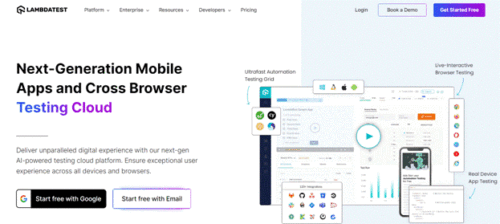
Key features include:
- Manual Testing:
LambdaTest enables intuitive interactive testing by allowing users to access a vast matrix of 3000+ browser and OS combinations. Testers can manually validate website functionality, UI appearance, and responsiveness and confirm fixes in real-time through an online virtual machine-based platform. Interactive use promotes exploratory test efforts.
- Automated Testing:
Test automation scripts can execute on the LambdaTest grid for faster feedback compared to manual testing alone. Scripts run tests across the desired desktop and mobile browsers in parallel. Automation helps shift left in release cycles through quick validation in staging environments.
- Mobile App Testing:
Along with desktop browser test automation, LambdaTest offers a cloud infrastructure of real Android and iOS devices for mobile app test automation. Tests assess mobile compatibility in target deployment environments. Automated testing delivers confidence for mobile release readiness.
- Advanced Capabilities:
Other notable highlights include geolocation testing, accessibility scans, visual testing, network traffic throttling, logs, and video recording. These capabilities bolster test coverage and defect diagnosis.
- Integrations:
Issue tracking integration with Jira, Asana, and Trello facilitates linkage between testing outcomes and dev teams. GitHub integration also streamlines commit workflows.
LambdaTest drives quality through comprehensive test coverage, advanced testing features, and CI/CD integrations. By providing instant access to a breadth of browsers/OS/devices far beyond local machines, it offers an agile pathway to cross-browser test assurance across modern web and mobile apps.
Selenium Box
Selenium Box simplifies Selenium and Appium test environments by providing a ready-to-run infrastructure for automated testing. It enables the execution of web and mobile test automation behind firewalls, including deployment in private clouds aligned to security policies.
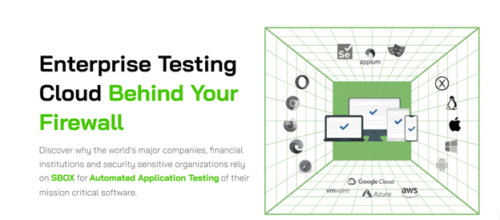
Key capabilities include:
- Scalable configuration that expands with testing needs.
- Maintenance-free browsers, pre-validated for compatibility.
- CI/CD integration for continuous testing.
- Manual browser access for interactive testing.
- Usage tracking, monitoring integrations, and reporting.
By handling infrastructure setup and configuration, Selenium Box reduces overhead in initiating automated cross-browser testing. Integrations and scaling also align with testing existing apps and new development efforts. These features accommodate enterprise and regulated industry testing demands, making Selenium Box a flexible cross-browser testing tool choice.
Ranorex Studio
Ranorex Studio simplifies the creation of automated UI tests across browsers without coding via drag-and-drop actions. This supports those without scripting expertise to build robust test automation.
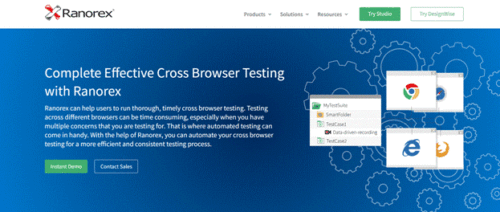
Key features include:
- Intuitive test case development that is easy to create, maintain, and learn.
- Reduced manual testing effort through test automation.
- Increased team productivity and software quality.
- Parallel test execution across multiple devices/browsers.
- Web scraping functionality to automatically fetch UI elements.
- Ranorex Web Test integration for web application testing.
By enabling codeless test automation that can run tests in parallel, Ranorex caters to shifting left in development cycles. Enhanced test coverage ultimately leads to higher-quality software. These user-friendly capabilities make Ranorex Studio an appealing cross-browser testing option for many organizations.
Virtuoso
Virtuoso simplifies test automation through natural language programming and AI to auto-generate full end-to-end test coverage across browsers and devices.
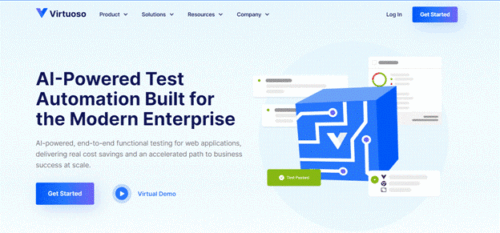
Key features include:
- No-code test authoring using plain English.
- Automatic test case creation from requirements.
- API testing integrated with functional UI flows.
- Visual regression testing.
- Support for live authoring and root cause analysis.
- Integrations with GitHub, Slack, and Azure.
- Automated test execution across browsers and mobile devices.
By leveraging advancements in AI and natural language processing, Virtuoso enables accelerated test automation without scripting to validate web and mobile apps. Automated cross-browser testing at scale is achievable earlier, resulting in higher-quality digital experiences.
QA Wolf
QA Wolf offers a team of test automation experts that act as an extension of in-house QA staff. They handle the creation, execution, and maintenance of complex test cases across browsers and devices.
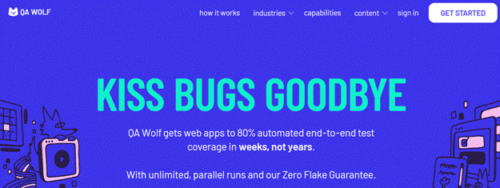
Key features include:
- End-to-end test coverage and planning.
- Parallel test execution.
- Detailed bug reporting with logs and video recordings.
- Real-time test status visibility.
- Integrations with existing systems.
- Ongoing test result reviews.
By leveraging dedicated automation engineers supplemented by analytics and visibility tools, QA Wolf provides a scalable testing solution. This reduces the overhead of managing extensive internal QA infrastructure. Cross-browser test automation and comprehensive test coverage help raise quality levels.
Comparium
Comparium enables easy visual validation of web application consistency across browsers and operating systems.
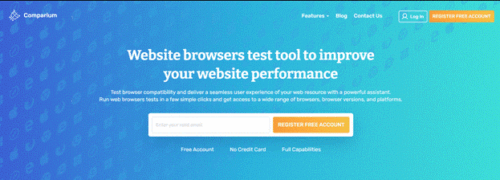
Key features include:
- The screenshot captures cross-browser/OS combinations.
- Manual and automated comparative image analysis.
- Visual discrepancy detection is highlighted for easy identification.
- Coverage for the latest browser versions.
- Real-time live testing by remotely connecting to target environments.
By consolidating screenshots and auto-detecting differences, Comparium simplifies validating cross-browser compatibility. The ability to perform real-time interactive tests without infrastructure setup also caters to ad-hoc validation needs. With strong visual analysis capabilities tailored to web testing, Comparium offers a lightweight yet powerful cross-browser testing option.
Autify
Autify enables the creation and execution of automated test cases across web, mobile, and desktop platforms. Users can record test scripts via a Chrome extension for reuse across 1300+ real browser/OS combinations.
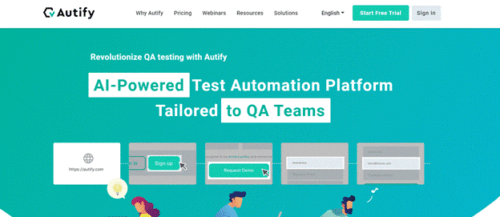
Key features include:
- Test recording capabilities.
- Cross-platform test execution, including real mobile devices.
- Visual regression testing to catch UI issues.
- Integrations with CI/CD pipelines, test management, and collaboration tools.
- Custom reporting dashboard.
By facilitating test reuse, cloud-based device access, and visual analysis, Autify simplifies setting up and running automation for cross-browser validation. Integrations also streamline executing tests as part of software delivery workflows. With the ability to scale automated testing, Autify provides comprehensive and continuous testing coverage across browsers and environments.
Conclusion
As web and mobile applications continue to proliferate across more diverse browsers, devices, and operating systems, comprehensive cross-browser testing is crucial for delivering flawless digital experiences. This article outlined modern tools that empower teams to achieve automated, continuous testing coverage through cloud infrastructure and intelligent capabilities. Key takeaways include leveraging simplified test authoring, multi-platform execution, advanced analytics, and integrations to shift testing left in development cycles.
Whether opting for open-source frameworks, commercial solutions, or test services, aligning the approach to an organization’s specific needs, skills, and outcomes is vital. With the right cross-browser testing strategy powered by these innovative tools, organizations can ship high-quality apps faster without compromising on compatibility or responsiveness across platforms. As consumer choice and technology diversity grow, prioritizing test automation and environment coverage is essential to thrive.







